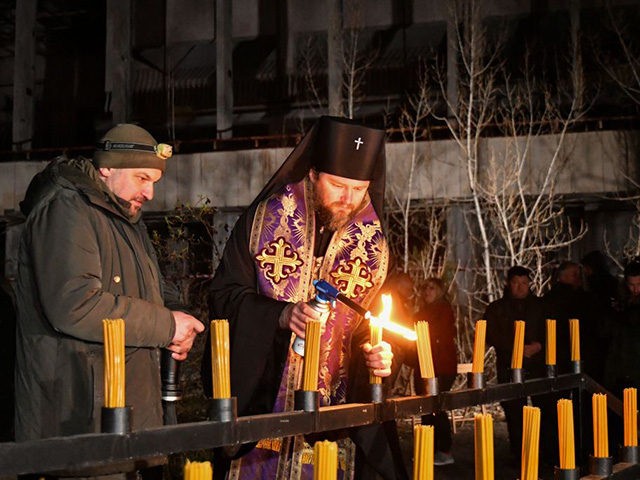Ukraine marked the 35th anniversary of the Chernobyl nuclear disaster Monday, remembering those lost attempting to contain the eruption of nuclear waste at the meltdown site and seeking a rightful place in history for the still-irradiated region destroyed by the incident.
On April 26, 1986, human error under the communist regime run from Moscow resulted in a nuclear reactor at the Chernobyl Nuclear Power Plant exploding, flooding most of Europe with nuclear fallout. The worst of the toxic blast affected northeast Ukraine and neighboring Belarus. Scientists estimate the nuclear disaster resulted in materials about 97 percent more radioactive than the material from the Hiroshima nuclear bombing being expelled into the air. The majority of those considered direct victims of the disaster were workers at the plant or first responders — 35 people honored in annual memorials both in Kyiv and in Pripyat, a town that once housed 50,000 people near the site of the plant.
Ukrainian President Volodymyr Zelensky visited the site of the disaster, known as the Chernobyl Exclusion Zone, on Monday, stating in remarks there that his government would work to rebuild the site into “an area of renaissance.”
“History does not go backwards, so Chernobyl today is a common challenge and a joint responsibility for the future and safety of the planet,” Zelensky said, also urging the world to cooperate to prevent a similar catastrophe in the future.
“Our task is to do everything possible to bolster security and strengthen safety to avoid and never repeat a similar disaster in the future,” Zelensky urged.
Reports do not indicate that Zelensky elaborated on how his government intended to bring “renaissance” to Chernobyl, though since becoming president in 2019, he has made similar statements.
“Chernobyl has been a negative part of Ukraine’s brand. The time has come to change this,” the president said in 2019. At the time, he signed an ordinance designating the exclusion zone an official tourist destination, which would allow the government to increase support for tour companies that sell day trips to abandoned Pripyat and the Chernobyl site. Zelensky also stated he hoped to expand access to the exclusion zone for scientists and create a “green corridor” to allow visits from those wishing to see the vast array of wildlife that has taken over what was once a large, industrialized town.
“To begin with, we will create a ‘green’ corridor for tourists and remove the prerequisites for petty corruption; there will no longer be huge lines at the checkpoint and sudden denials of which people learn when they arrive at the checkpoint,” Zelensky said at the time. “The ban to shoot videos will be lifted, as well as other nonsensical restrictions. Let’s finally stop scaring people, visitors, and make the exclusion zone a scientific and tourist magnet in the future.”
Kyiv began making moves last year urging the United Nations to designate the exclusion zone a UNESCO World Heritage Site. The agency’s World Heritage List features locations of “cultural and natural heritage around the world considered to be of outstanding value to humanity,” marking them as especially valuable and worth investing in maintaining.
“We believe that putting Chernobyl on the UNESCO heritage list is a first and important step towards having this great place as a unique destination of interest for the whole of mankind,” Ukrainian Culture Minister Oleksandr Tkachenko told Reuters this year. “The importance of the Chernobyl zone lays far beyond Ukraine’s borders. It is not only about commemoration, but also history and people’s rights.”
In 1986, Soviet authorities initially refused to admit that anything had happened at the power plant, leaving the residents of Pripyat within what is now known as the Chernobyl Exclusion Zone. After two days, Moscow admitted that something had occurred and begun evacuating Pripyat, but claiming to residents that they would soon be able to return. As of Monday, Kyiv still considers the zone uninhabitable and Pripyat has become a tourist destination as a ghost town, save for a small population of elderly residents who never evacuated in 1986. Ukrainian officials have pushed to name the abandoned territory a nature preserve and have begun a campaign to have the United Nations designated the Exclusion Zone a World Heritage site, offering it protection as a treasure of civilization.
The number of people who died as a result of the nuclear waste disseminated throughout Europe remains a subject of much controversy. In 2011, the Union of Concerned Scientists estimated that, by the time the nuclear disaster will no longer affect anyone alive, as many as 57,000 deaths will be attributable to it, particularly through cancer diagnoses tied to exposure to fallout.
The number of people who have worked in and around Chernobyl to contain nuclear waste since 1986 is also a matter of debate, but even modest estimates suggest the number of “liquidators,” as they are known in the country, is in the hundreds of thousands. As the United Nations highlighted marking this year’s anniversary, many liquidators suffered ill health after their service, but as doctors could not directly tie their conditions to their presence at the Chernobyl site, they did not receive significant compensation the way that those few cases directly tied to the disaster did.
Death estimates also tend not to include individuals diagnosed with severe problems at birth after either being born in the area or their parents being exposed to fallout. In Belarus, one such condition in children — multiple holes appearing in the hearts of infants — became known as “Chernobyl heart” for its suspected ties to the disaster. Also omitted from the death tolls are individuals who died at relatively young ages of heart attacks, alcoholism, or other conditions sometimes tied to stress and mental health following their evacuation from Pripyat.
Russia, the core republic of the former Soviet Union, has yet to formally apologize for the Chernobyl nuclear disaster. A former Soviet intelligence agent, Vladimir Putin, is the nation’s president.

COMMENTS
Please let us know if you're having issues with commenting.